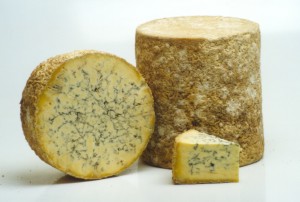
|
|
||||||
Stilton is known as the 'King of Cheeses' and is one of the few British cheeses to be cherished in other countries. It was mentioned in the book by Daniel Defoe 'A Tour through the Whole Island of Great Britain 1724-26' where Stilton was mentioned as 'a town famous for its cheese'. In fact Stilton was never made in Stilton. Many believe it was first made by Mrs Stilton, head dairymaid to the 5th Duchess of Rutland at Belvoir, but no documentary evidence exists to support this. Others believe that it was made on a small farm at Little Dalby, near Melton Mowbray, by a Mrs Elizabeth Orton. The recipe was kept a family secret and the cheese known at that time as 'Quenby'. However one of her daughters married an inn keeper and moved to the Bell Inn at Stilton in Cambridgeshire, and from here it was sold to coach travellers on the Great North Road. Its fame soon spread. Nowadays Stilton is made in seven dairies scattered around Nottinghamshire, Leicestershire and Derbyshire. It is protected by a certified trademark and its making has been strictly controlled by 'The Stilton Cheese Makers Association' since the 1900s. Milk is collected from neighbouring farms and pasteurised at each dairy. All Stilton is pasteurised today. A culture of Penicillium roquefortii is added to the milk with the starter and culture added a short time later. The curds are cut by hand into small cubes and allowed to settle at the bottom of the vat. They are left to drain until the following morning when they are milled, salted and placed into hoops for three days to a week. At the Colston Basset dairy the curds are treated very gently and by hand so as not to damage them - this ensures that Colston Bassett Stilton is the creamiest Stilton made. The cheeses are turned daily to drain further. Once removed from the hoops the cheese is rubbed down by hand to smooth out creases and to seal the edges. The cheeses are then stored in precise conditions of temperature and humidity for an average of three to four months, when the characteristic crust will develop. During the first month the cheeses are turned every day and at eight weeks they are pierced with stainless steel needles to promote the veining. The best Stilton is made from summer milk and is distinguishable by a slightly yellower paste. Although it is excellent at Christmas it must also be enjoyed at its absolute peak in the autumn. The cheese has a velvet, close texture with a pale ivory paste, grading to amber at the edges and marbled with greenish blue veins. The rind is dry and crusty, grey-brown in colour, slightly wrinkled and with white powdery patches. The flavour ranges from mild with a sharp edge when young, to rich and tangy when mature. Stilton is traditionally accompanied with port. There is the custom of pouring port into the Stilton and 'digging' the cheese out with a special spoon. This custom was born when whole cheeses were served at banquets and where the entire cheese was consumed at the one sitting. Many still enjoy this tradition but if you are planning to enjoy a Stilton over a period longer than a week then this method should avoided. Any left over Stilton can be used to make excellent soups and sauces. Each cheese is approximately 25cm in diameter, 30cm high, 7 to 8kg in weigh and has a fat content of 48%. Baby Stiltons make an impressive feature at the festive dinner table - they are 12cm in diameter, 20cm high, weigh 2.5kg and have a 48% fat content. Stilton in ceramic pots and endless other styles of packaging, as attractive as they may be, are to be avoided. Click here or press your 'Back' button to return |
Click here or press your 'Back' button to return
|
||||||
| All articles © www.teddingtoncheese.co.uk | |||||||
